Respiratory Acidosis: Patient Case Analysis and Management
VerifiedAdded on 2022/11/14
|5
|1037
|300
Case Study
AI Summary
This case study focuses on a patient presenting with dyspnea and symptoms suggestive of respiratory acidosis. The analysis begins with an interpretation of the patient's arterial blood gas (ABG) results, including a low pH, low pO2, high pCO2, and elevated HCO3 levels, leading to a diagnosis of partially compensated respiratory acidosis. The document differentiates respiratory acidosis from other acid-base disorders such as respiratory alkalosis, metabolic acidosis, and metabolic alkalosis. The treatment strategy emphasizes addressing the underlying cause of impaired gaseous exchange, including the use of bronchodilators and Bi-PAP for respiratory support. Nursing interventions are detailed, such as airway management, oxygen therapy, and patient education on risk factors. The importance of careful monitoring to prevent rapid pH changes is also highlighted.
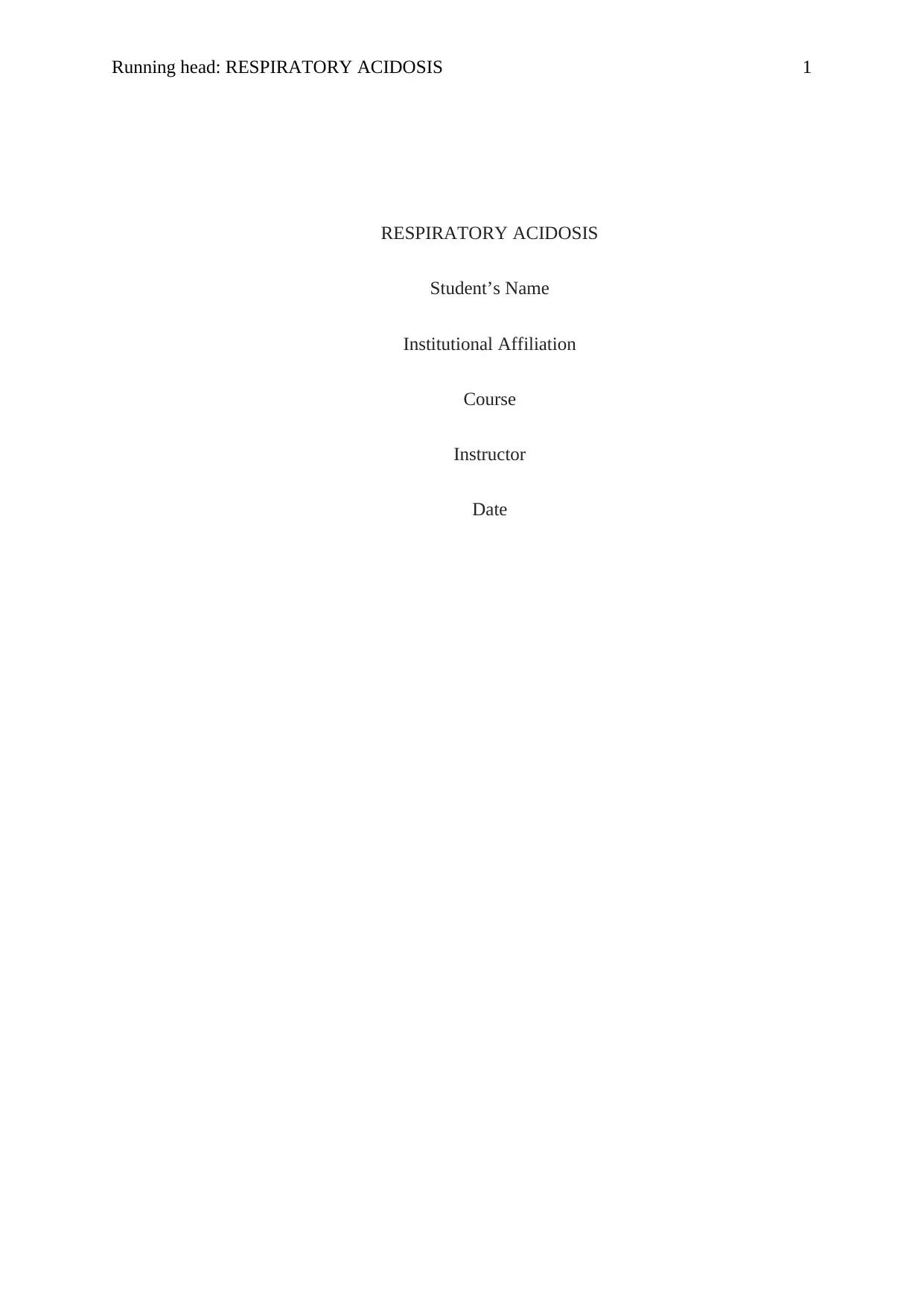
Running head: RESPIRATORY ACIDOSIS 1
RESPIRATORY ACIDOSIS
Student’s Name
Institutional Affiliation
Course
Instructor
Date
RESPIRATORY ACIDOSIS
Student’s Name
Institutional Affiliation
Course
Instructor
Date
Paraphrase This Document
Need a fresh take? Get an instant paraphrase of this document with our AI Paraphraser
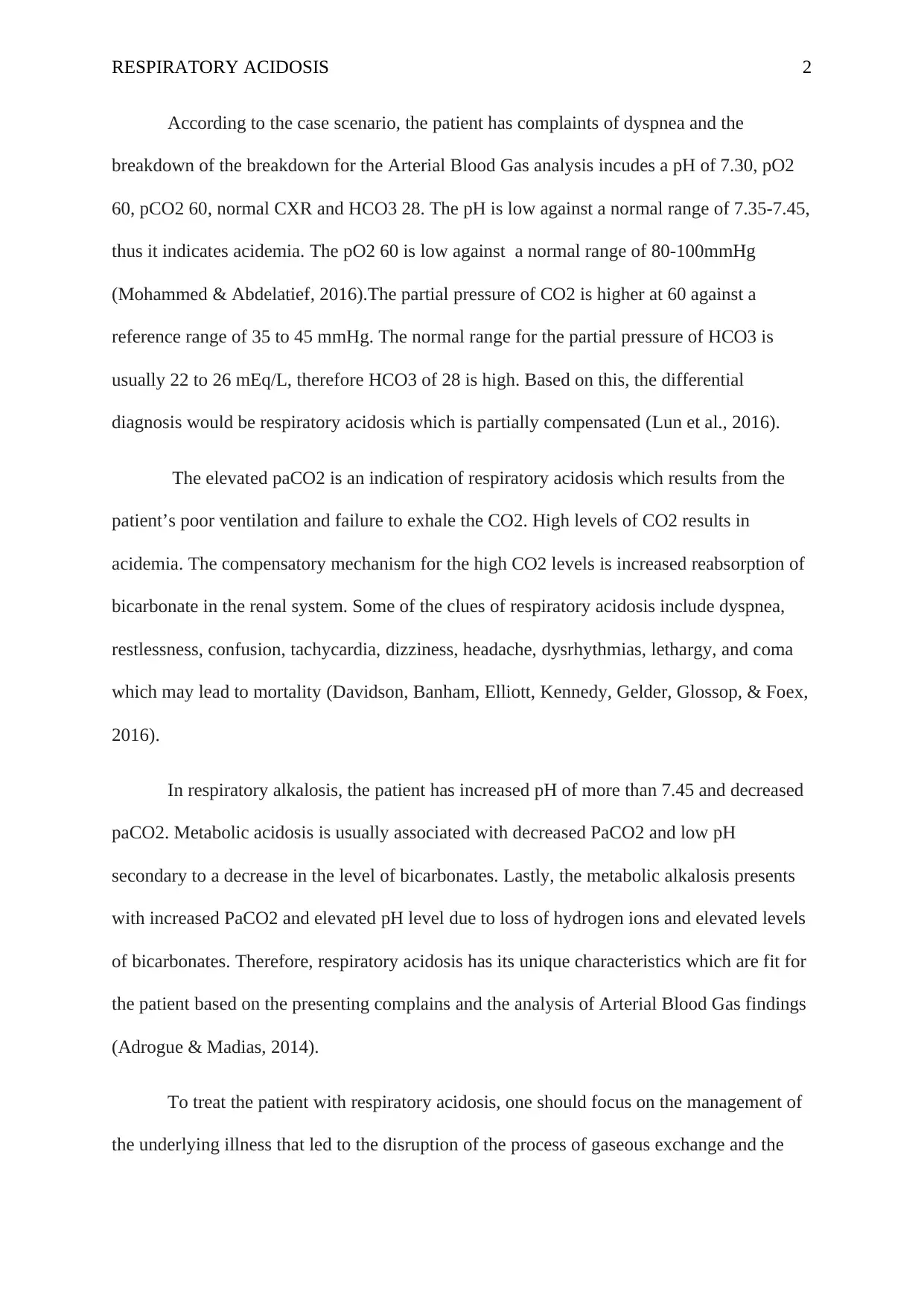
RESPIRATORY ACIDOSIS 2
According to the case scenario, the patient has complaints of dyspnea and the
breakdown of the breakdown for the Arterial Blood Gas analysis incudes a pH of 7.30, pO2
60, pCO2 60, normal CXR and HCO3 28. The pH is low against a normal range of 7.35-7.45,
thus it indicates acidemia. The pO2 60 is low against a normal range of 80-100mmHg
(Mohammed & Abdelatief, 2016).The partial pressure of CO2 is higher at 60 against a
reference range of 35 to 45 mmHg. The normal range for the partial pressure of HCO3 is
usually 22 to 26 mEq/L, therefore HCO3 of 28 is high. Based on this, the differential
diagnosis would be respiratory acidosis which is partially compensated (Lun et al., 2016).
The elevated paCO2 is an indication of respiratory acidosis which results from the
patient’s poor ventilation and failure to exhale the CO2. High levels of CO2 results in
acidemia. The compensatory mechanism for the high CO2 levels is increased reabsorption of
bicarbonate in the renal system. Some of the clues of respiratory acidosis include dyspnea,
restlessness, confusion, tachycardia, dizziness, headache, dysrhythmias, lethargy, and coma
which may lead to mortality (Davidson, Banham, Elliott, Kennedy, Gelder, Glossop, & Foex,
2016).
In respiratory alkalosis, the patient has increased pH of more than 7.45 and decreased
paCO2. Metabolic acidosis is usually associated with decreased PaCO2 and low pH
secondary to a decrease in the level of bicarbonates. Lastly, the metabolic alkalosis presents
with increased PaCO2 and elevated pH level due to loss of hydrogen ions and elevated levels
of bicarbonates. Therefore, respiratory acidosis has its unique characteristics which are fit for
the patient based on the presenting complains and the analysis of Arterial Blood Gas findings
(Adrogue & Madias, 2014).
To treat the patient with respiratory acidosis, one should focus on the management of
the underlying illness that led to the disruption of the process of gaseous exchange and the
According to the case scenario, the patient has complaints of dyspnea and the
breakdown of the breakdown for the Arterial Blood Gas analysis incudes a pH of 7.30, pO2
60, pCO2 60, normal CXR and HCO3 28. The pH is low against a normal range of 7.35-7.45,
thus it indicates acidemia. The pO2 60 is low against a normal range of 80-100mmHg
(Mohammed & Abdelatief, 2016).The partial pressure of CO2 is higher at 60 against a
reference range of 35 to 45 mmHg. The normal range for the partial pressure of HCO3 is
usually 22 to 26 mEq/L, therefore HCO3 of 28 is high. Based on this, the differential
diagnosis would be respiratory acidosis which is partially compensated (Lun et al., 2016).
The elevated paCO2 is an indication of respiratory acidosis which results from the
patient’s poor ventilation and failure to exhale the CO2. High levels of CO2 results in
acidemia. The compensatory mechanism for the high CO2 levels is increased reabsorption of
bicarbonate in the renal system. Some of the clues of respiratory acidosis include dyspnea,
restlessness, confusion, tachycardia, dizziness, headache, dysrhythmias, lethargy, and coma
which may lead to mortality (Davidson, Banham, Elliott, Kennedy, Gelder, Glossop, & Foex,
2016).
In respiratory alkalosis, the patient has increased pH of more than 7.45 and decreased
paCO2. Metabolic acidosis is usually associated with decreased PaCO2 and low pH
secondary to a decrease in the level of bicarbonates. Lastly, the metabolic alkalosis presents
with increased PaCO2 and elevated pH level due to loss of hydrogen ions and elevated levels
of bicarbonates. Therefore, respiratory acidosis has its unique characteristics which are fit for
the patient based on the presenting complains and the analysis of Arterial Blood Gas findings
(Adrogue & Madias, 2014).
To treat the patient with respiratory acidosis, one should focus on the management of
the underlying illness that led to the disruption of the process of gaseous exchange and the
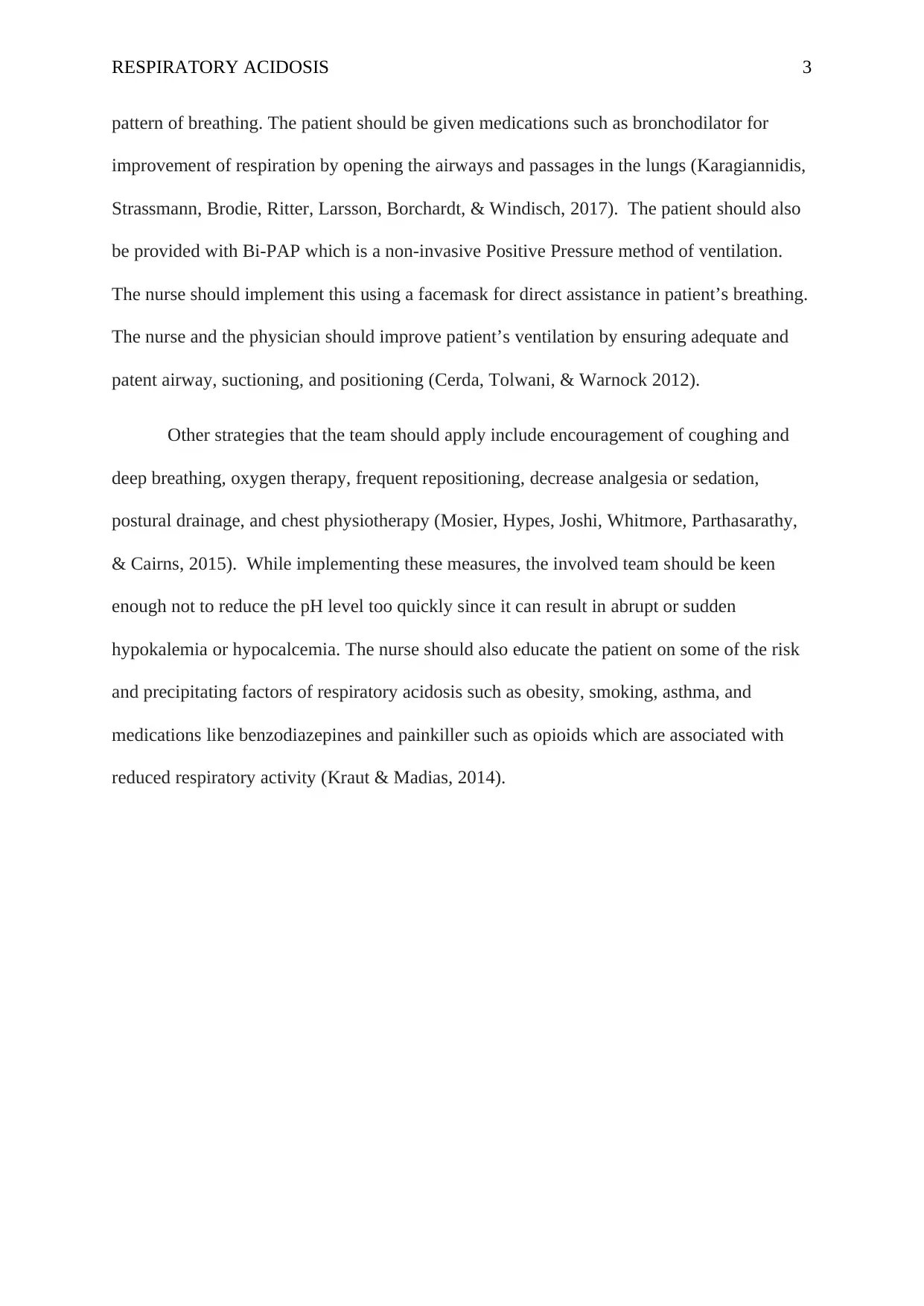
RESPIRATORY ACIDOSIS 3
pattern of breathing. The patient should be given medications such as bronchodilator for
improvement of respiration by opening the airways and passages in the lungs (Karagiannidis,
Strassmann, Brodie, Ritter, Larsson, Borchardt, & Windisch, 2017). The patient should also
be provided with Bi-PAP which is a non-invasive Positive Pressure method of ventilation.
The nurse should implement this using a facemask for direct assistance in patient’s breathing.
The nurse and the physician should improve patient’s ventilation by ensuring adequate and
patent airway, suctioning, and positioning (Cerda, Tolwani, & Warnock 2012).
Other strategies that the team should apply include encouragement of coughing and
deep breathing, oxygen therapy, frequent repositioning, decrease analgesia or sedation,
postural drainage, and chest physiotherapy (Mosier, Hypes, Joshi, Whitmore, Parthasarathy,
& Cairns, 2015). While implementing these measures, the involved team should be keen
enough not to reduce the pH level too quickly since it can result in abrupt or sudden
hypokalemia or hypocalcemia. The nurse should also educate the patient on some of the risk
and precipitating factors of respiratory acidosis such as obesity, smoking, asthma, and
medications like benzodiazepines and painkiller such as opioids which are associated with
reduced respiratory activity (Kraut & Madias, 2014).
pattern of breathing. The patient should be given medications such as bronchodilator for
improvement of respiration by opening the airways and passages in the lungs (Karagiannidis,
Strassmann, Brodie, Ritter, Larsson, Borchardt, & Windisch, 2017). The patient should also
be provided with Bi-PAP which is a non-invasive Positive Pressure method of ventilation.
The nurse should implement this using a facemask for direct assistance in patient’s breathing.
The nurse and the physician should improve patient’s ventilation by ensuring adequate and
patent airway, suctioning, and positioning (Cerda, Tolwani, & Warnock 2012).
Other strategies that the team should apply include encouragement of coughing and
deep breathing, oxygen therapy, frequent repositioning, decrease analgesia or sedation,
postural drainage, and chest physiotherapy (Mosier, Hypes, Joshi, Whitmore, Parthasarathy,
& Cairns, 2015). While implementing these measures, the involved team should be keen
enough not to reduce the pH level too quickly since it can result in abrupt or sudden
hypokalemia or hypocalcemia. The nurse should also educate the patient on some of the risk
and precipitating factors of respiratory acidosis such as obesity, smoking, asthma, and
medications like benzodiazepines and painkiller such as opioids which are associated with
reduced respiratory activity (Kraut & Madias, 2014).
⊘ This is a preview!⊘
Do you want full access?
Subscribe today to unlock all pages.

Trusted by 1+ million students worldwide
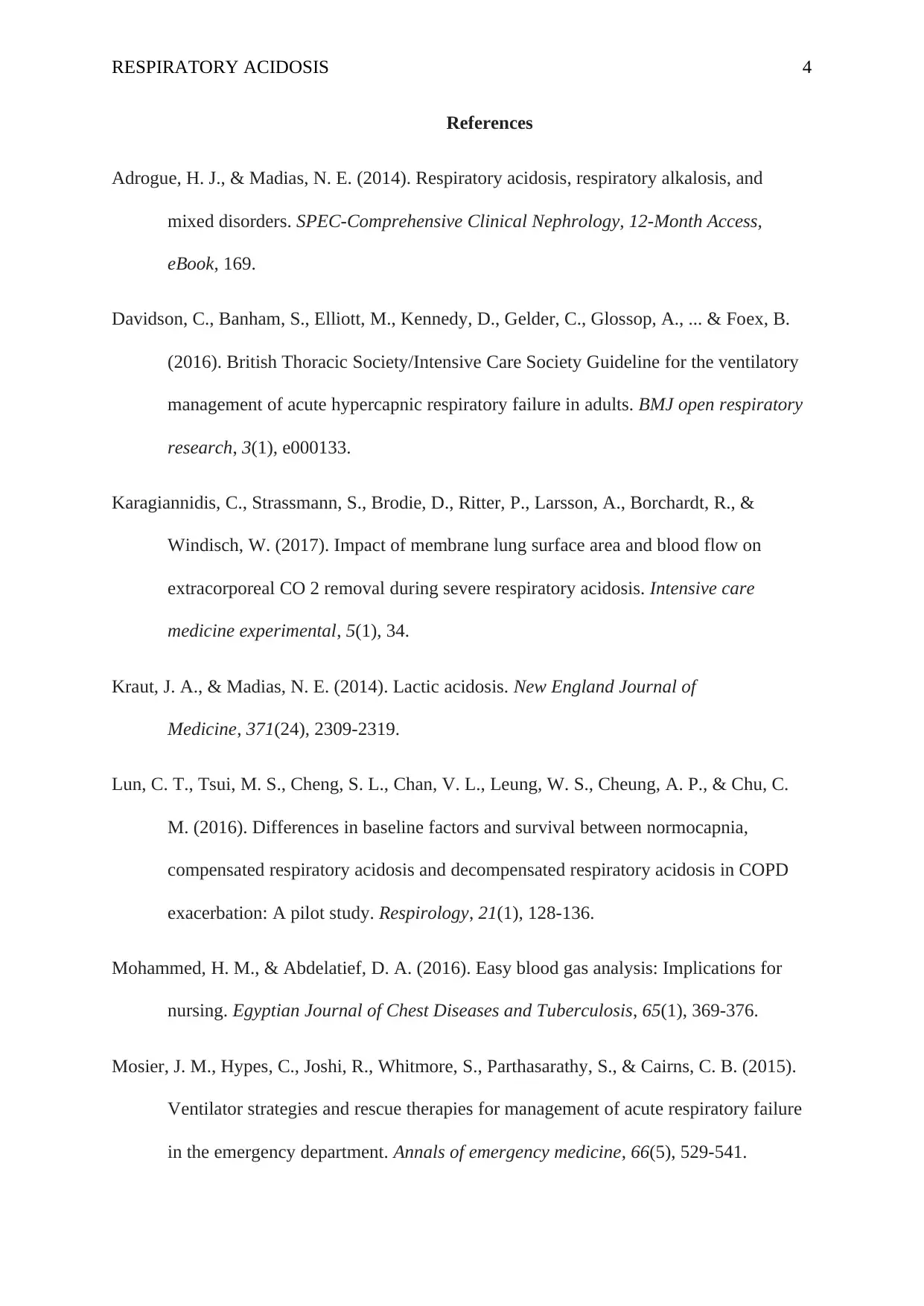
RESPIRATORY ACIDOSIS 4
References
Adrogue, H. J., & Madias, N. E. (2014). Respiratory acidosis, respiratory alkalosis, and
mixed disorders. SPEC-Comprehensive Clinical Nephrology, 12-Month Access,
eBook, 169.
Davidson, C., Banham, S., Elliott, M., Kennedy, D., Gelder, C., Glossop, A., ... & Foex, B.
(2016). British Thoracic Society/Intensive Care Society Guideline for the ventilatory
management of acute hypercapnic respiratory failure in adults. BMJ open respiratory
research, 3(1), e000133.
Karagiannidis, C., Strassmann, S., Brodie, D., Ritter, P., Larsson, A., Borchardt, R., &
Windisch, W. (2017). Impact of membrane lung surface area and blood flow on
extracorporeal CO 2 removal during severe respiratory acidosis. Intensive care
medicine experimental, 5(1), 34.
Kraut, J. A., & Madias, N. E. (2014). Lactic acidosis. New England Journal of
Medicine, 371(24), 2309-2319.
Lun, C. T., Tsui, M. S., Cheng, S. L., Chan, V. L., Leung, W. S., Cheung, A. P., & Chu, C.
M. (2016). Differences in baseline factors and survival between normocapnia,
compensated respiratory acidosis and decompensated respiratory acidosis in COPD
exacerbation: A pilot study. Respirology, 21(1), 128-136.
Mohammed, H. M., & Abdelatief, D. A. (2016). Easy blood gas analysis: Implications for
nursing. Egyptian Journal of Chest Diseases and Tuberculosis, 65(1), 369-376.
Mosier, J. M., Hypes, C., Joshi, R., Whitmore, S., Parthasarathy, S., & Cairns, C. B. (2015).
Ventilator strategies and rescue therapies for management of acute respiratory failure
in the emergency department. Annals of emergency medicine, 66(5), 529-541.
References
Adrogue, H. J., & Madias, N. E. (2014). Respiratory acidosis, respiratory alkalosis, and
mixed disorders. SPEC-Comprehensive Clinical Nephrology, 12-Month Access,
eBook, 169.
Davidson, C., Banham, S., Elliott, M., Kennedy, D., Gelder, C., Glossop, A., ... & Foex, B.
(2016). British Thoracic Society/Intensive Care Society Guideline for the ventilatory
management of acute hypercapnic respiratory failure in adults. BMJ open respiratory
research, 3(1), e000133.
Karagiannidis, C., Strassmann, S., Brodie, D., Ritter, P., Larsson, A., Borchardt, R., &
Windisch, W. (2017). Impact of membrane lung surface area and blood flow on
extracorporeal CO 2 removal during severe respiratory acidosis. Intensive care
medicine experimental, 5(1), 34.
Kraut, J. A., & Madias, N. E. (2014). Lactic acidosis. New England Journal of
Medicine, 371(24), 2309-2319.
Lun, C. T., Tsui, M. S., Cheng, S. L., Chan, V. L., Leung, W. S., Cheung, A. P., & Chu, C.
M. (2016). Differences in baseline factors and survival between normocapnia,
compensated respiratory acidosis and decompensated respiratory acidosis in COPD
exacerbation: A pilot study. Respirology, 21(1), 128-136.
Mohammed, H. M., & Abdelatief, D. A. (2016). Easy blood gas analysis: Implications for
nursing. Egyptian Journal of Chest Diseases and Tuberculosis, 65(1), 369-376.
Mosier, J. M., Hypes, C., Joshi, R., Whitmore, S., Parthasarathy, S., & Cairns, C. B. (2015).
Ventilator strategies and rescue therapies for management of acute respiratory failure
in the emergency department. Annals of emergency medicine, 66(5), 529-541.
Paraphrase This Document
Need a fresh take? Get an instant paraphrase of this document with our AI Paraphraser
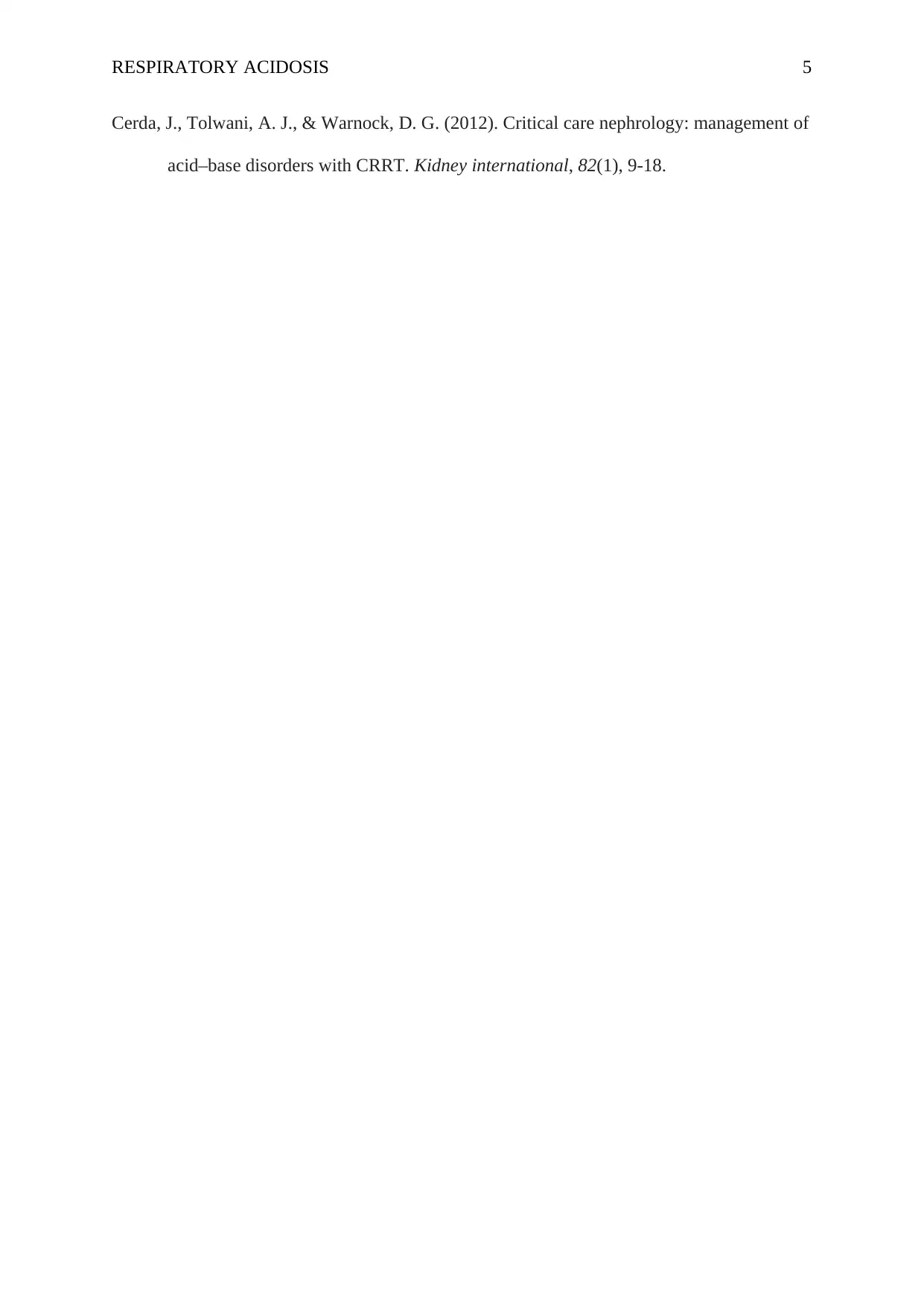
RESPIRATORY ACIDOSIS 5
Cerda, J., Tolwani, A. J., & Warnock, D. G. (2012). Critical care nephrology: management of
acid–base disorders with CRRT. Kidney international, 82(1), 9-18.
Cerda, J., Tolwani, A. J., & Warnock, D. G. (2012). Critical care nephrology: management of
acid–base disorders with CRRT. Kidney international, 82(1), 9-18.
1 out of 5
Related Documents
Your All-in-One AI-Powered Toolkit for Academic Success.
+13062052269
info@desklib.com
Available 24*7 on WhatsApp / Email
![[object Object]](/_next/static/media/star-bottom.7253800d.svg)
Unlock your academic potential
Copyright © 2020–2025 A2Z Services. All Rights Reserved. Developed and managed by ZUCOL.





